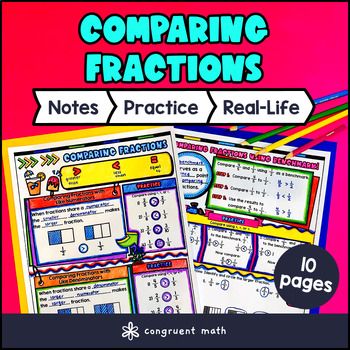Want more ideas and freebies?
Get my free resource library with digital & print activities—plus tips over email.
Join for Free Resources →
$4.25
Ever wondered how to teach comparing fractions in an engaging way to your 4th grade students?
In this lesson plan, students will learn how to compare fractions using benchmark fractions and equivalent fractions, applying >, =, or < symbols. Through artistic, interactive guided notes, checks for understanding, a color-by-code activity, and a maze worksheet, students gain a comprehensive understanding of comparing fractions.
The lesson culminates with a real-life example that explores how comparing fractions helps in everyday decision-making and problem-solving.

$4.25
After this lesson, students will be able to:
Before this lesson, students should be familiar with:
As a hook, ask students why it might be important to know which fraction is larger when sharing items like slices of pizza or pieces of cake. Encourage them to think about real-life situations where comparing fractions helps make fair decisions. Refer to the last page of the guided notes as well as the FAQs below for additional ideas on engaging students with real-life relevance.
Use the first page of the guided notes to introduce the concept of comparing fractions with different numerators but the same denominator. Walk through how the size of the numerator affects the fraction’s value when denominators are equal, emphasizing that a larger numerator means a larger fraction. Demonstrate this visually by having students doodle or color fractions to reinforce understanding. Refer to the FAQ below for a detailed walk-through and suggestions on responding to common student questions about numerator comparison.
Use the second page of the guided notes to introduce comparing fractions with different denominators. Teach students how to create equivalent fractions by multiplying numerator and denominator to reach common denominators, or alternatively, how to compare fractions using benchmark fractions like 1/2. Guide students through several examples, showing step-by-step how to determine which fraction is greater or if they are equal. Encourage students to sketch visual models or number lines in their guided notes to cement the concept. Refer to the FAQ below for strategies on clarifying confusion around equivalent fractions and benchmark comparisons.
If you notice from the checks for understanding that some students struggle with either numerators, denominators, or creating equivalent fractions, pull these students aside for targeted reteaching using additional visual aids or manipulatives. Meanwhile, students demonstrating proficiency can begin the practice exercises to deepen their understanding. This differentiation will help ensure all students are prepared before moving on to application activities.
Have students practice comparing fractions using the color by code and maze activities. Walk around to answer student questions.
Fast finishers can dive into the problem sets activity for extra practice. You can assign it as homework for the remainder of the class.
Bring the class back together, and introduce the concept of using fraction comparison to make everyday decisions, such as choosing the better deal when shopping or sharing food equally among friends. Discuss how comparing fractions helps us understand quantities in real-life situations like measuring ingredients in recipes or dividing time fairly. Refer to the FAQ for more ideas on how to teach it!
If you’re looking for digital practice for comparing fractions, try my Pixel Art activities in Google Sheets. Every answer is automatically checked, and correct answers unlock parts of a mystery picture. It’s incredibly fun, and a powerful tool for differentiation.
Here’s 1 activity to explore:
Comparing fractions means determining which fraction is greater, smaller, or if they are equal by looking at their numerators and denominators.
To compare fractions with different denominators, you can:
Benchmark fractions are common fractions such as 0, 1/2, and 1 that help you estimate the value of other fractions. They make comparing fractions easier by providing reference points.
When numerators are different, you can compare fractions by:
The symbols used to compare fractions are:
Comparing fractions is important in real life for activities such as cooking, measuring, and dividing things fairly. It helps you understand quantities and make decisions based on size or proportion.
Helpful strategies include:
To practice comparing fractions effectively:
Get my free resource library with digital & print activities—plus tips over email.
Join for Free Resources →